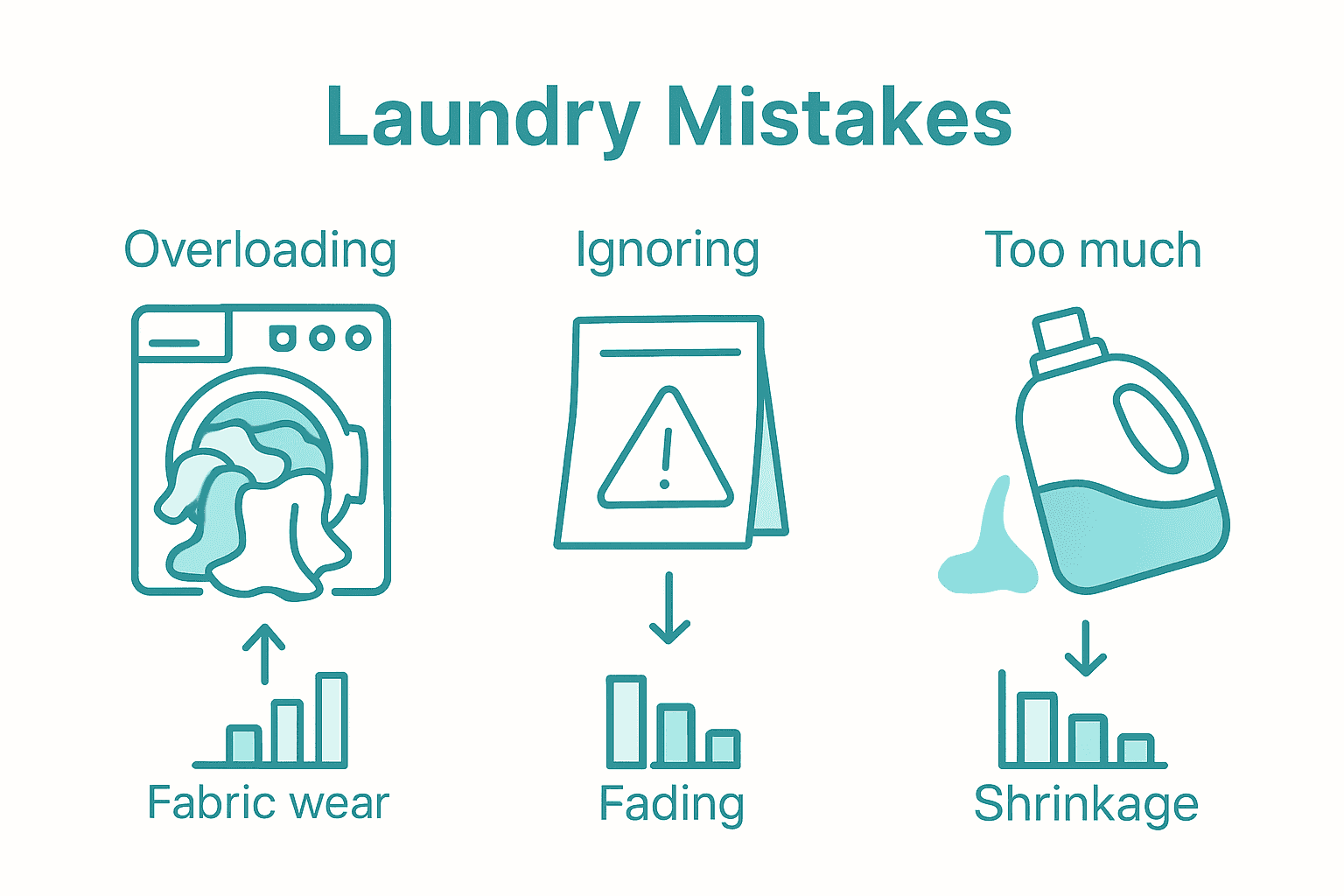Common Laundry Mistakes: Complete Guide to Clothes Care
Laundry mishaps can turn a favorite shirt into a faded, shrunken regret before you know it. Nearly 80 percent of people admit to making at least one major mistake when doing laundry, often without realizing the true cost. Simple habits like overloading the machine or skipping label instructions can weaken fabrics and drain your budget. If you want your clothes to last longer and look better, understanding these common laundry errors is your best first step.
Table of Contents
- What Are Common Laundry Mistakes?
- Types of Laundry Errors and Misconceptions
- How Washing Methods Affect Clothes Quality
- Understanding Fabric Care Labels and Symbols
- Risks of Incorrect Laundry Products and Settings
- Preventing Color Bleeding, Shrinkage, and Damage
Key Takeaways
| Point | Details |
|---|---|
| Avoid Overloading Machines | Overloading hampers cleaning efficiency and damages fabric. Aim to fill washers no more than 75% full. |
| Properly Sort Laundry | Separate items by color and fabric type to prevent bleeding and damage. Follow guidelines for specific sorting categories. |
| Adhere to Care Labels | Fabric care labels provide essential instructions for washing and drying to maintain clothing quality. Ignoring them can lead to irreversible damage. |
| Use Correct Detergents and Settings | Choose the right detergent for fabric types and select appropriate washing machine settings to avoid wear and decrease cleaning effectiveness. |
What Are Common Laundry Mistakes?
Laundry might seem straightforward, but many people unknowingly make mistakes that can damage clothes, reduce cleaning effectiveness, and shorten the lifespan of their favorite garments. According to dlionline.org, the Dry Cleaning and Laundry Institute International has identified several critical errors that can compromise your clothing care routine.
Overloading the Washer is one of the most common mistakes people make. When you cram too many clothes into your washing machine, you’re actually preventing proper cleaning and causing unnecessary wear on your fabrics. Clothes need room to move and get thoroughly cleaned.
 A good rule of thumb is to fill your washer no more than 75% full, allowing water and detergent to circulate effectively.
A good rule of thumb is to fill your washer no more than 75% full, allowing water and detergent to circulate effectively.
Another significant mistake is improper sorting. Not separating your clothes by color, fabric type, and washing instructions can lead to disastrous results. Dark colors might bleed onto lighter fabrics, delicate items can get damaged, and heavy fabrics can wear out more sensitive materials. The American Cleaning Institute recommends carefully reading product labels and sorting your laundry into these categories:
- White and light-colored items
- Dark and colored clothing
- Delicate fabrics
- Heavy items like towels and denim
Temperature and water settings are also crucial. Using low water temperatures might seem like an energy-saving strategy, but it can result in inadequate cleaning. Some stains and bacteria require warmer water to be effectively removed. Each fabric type has its ideal washing temperature, so always check the care label.
Lastly, dryer mistakes can be just as damaging as washing errors. Overloading your dryer leads to longer drying times and can cause permanent wrinkles in heat-sensitive fabrics. Always give your clothes enough space to tumble freely, and consider air-drying delicate items to prevent potential damage.
By understanding and avoiding these common laundry mistakes, you can extend the life of your clothes, keep them looking fresh, and make your laundry routine more efficient and effective.
Types of Laundry Errors and Misconceptions
Laundry care is riddled with common myths and misunderstandings that can lead to unexpected clothing damage and ineffective cleaning. The American Cleaning Institute highlights several widespread misconceptions that many people unknowingly believe about their laundry routine.
Detergent Overuse is a significant error many people make. Contrary to popular belief, more detergent does not equal cleaner clothes. In fact, using too much detergent can cause several problems:
- Soap residue buildup on fabrics
- Reduced washing machine efficiency
- Potential skin irritation from chemical residues
- Unnecessary wear on clothing fibers
Another critical misconception involves water temperature. Many people assume that cold water is always the best option for washing clothes. According to dlionline.org, different fabrics and stains require specific water temperatures for effective cleaning. Some stains and bacteria can only be properly removed with warmer water settings.
Fabric Care Labels are often misunderstood or completely ignored. These small tags contain crucial information about how to properly clean and maintain your clothing. Some people view them as optional suggestions, but they are actually detailed instructions from the manufacturer about the best care for each specific garment.
Stain treatment is another area full of misconceptions. People often reach for harsh chemicals or attempt DIY treatments without understanding fabric composition. What works for one type of fabric might completely ruin another. Always test stain removal methods on a small, hidden area first, and follow specific fabric care guidelines.
Lastly, machine settings are frequently misused. Not all clothes should be washed on the same cycle or with the same level of agitation. Delicate items require gentler treatment, while heavy fabrics need more robust washing conditions. Understanding your washing machine’s various settings can significantly extend the life of your clothing and improve overall cleaning effectiveness.
How Washing Methods Affect Clothes Quality
Your laundry routine can make or break the longevity and appearance of your clothing. According to cleaninginstitute.org, improper washing methods can dramatically impact fabric quality, leading to premature wear and tear.
Machine Load Size plays a critical role in clothing preservation. dlionline.org emphasizes that overloading washers and dryers causes multiple problems:
- Reduced cleaning effectiveness
- Increased fabric friction and wear
- Uneven detergent distribution
- Potential permanent fabric damage
Water temperature is another crucial factor in maintaining clothes quality. Different fabrics require specific temperatures to prevent shrinkage, color fading, and fiber breakdown. Delicate items like silk and wool need gentler, cooler settings, while cotton and heavily soiled items benefit from warmer water that helps remove dirt and bacteria more effectively.
Fabric Friction occurs during washing and can significantly impact clothing durability. The mechanical action of washing machines causes fibers to rub against each other, which can lead to pilling, stretching, and accelerated wear. To minimize this, consider these strategies:
- Use gentle cycle for delicate items
- Turn clothes inside out before washing
- Separate heavy and light fabrics
- Use mesh laundry bags for fragile garments
Detergent selection also matters tremendously. Using the wrong type of detergent can cause color bleeding, fabric weakening, and residue buildup. Always match your detergent to the fabric type and follow manufacturer recommendations.
Ultimately, understanding how different washing methods impact fabric quality can help you extend the life of your clothing, save money, and keep your wardrobe looking fresh and new for years to come.
Understanding Fabric Care Labels and Symbols
Decoding the mysterious world of fabric care labels can feel like solving a complex puzzle. The Federal Trade Commission provides critical guidelines to help consumers understand these essential garment care instructions.
Washing Symbols are the most common and critical care instructions. These tiny icons provide detailed guidance on how to clean your clothing safely. Here’s a breakdown of key washing symbols:
- A bucket symbol indicates washing instructions
- Numbers inside the bucket represent maximum water temperature
- Horizontal lines under the bucket suggest gentle cycle settings
- Diagonal lines typically mean permanent press or delicate handling
Drying symbols are equally important. The American Cleaning Institute emphasizes that incorrect drying can cause more damage than improper washing. Typical drying symbols include:
- A square represents tumble drying
- Dots inside the square indicate heat settings
- A circle inside the square means professional dry cleaning recommended
- Crossed-out symbols signal ‘do not’ for that specific action
Fabric Composition Matters. Not all fabrics respond the same way to washing and drying. Natural fibers like cotton and wool have different care requirements compared to synthetic materials like polyester and nylon. Always check the fabric composition tag alongside the care label for the most accurate instructions.
Understanding these symbols can save you from expensive clothing mishaps. A single misread label could result in shrinkage, color bleeding, or permanent fabric damage. Take a moment to familiarize yourself with these universal symbols, and you’ll become a laundry care expert in no time.

Risks of Incorrect Laundry Products and Settings
The American Cleaning Institute warns that seemingly minor laundry mistakes can lead to significant and often irreversible clothing damage. Understanding these risks is crucial for maintaining your wardrobe’s quality and longevity.
Detergent Selection is more complex than most people realize. Different fabrics require specific cleaning agents, and using the wrong product can cause multiple problems:
- Permanent color fading
- Fabric fiber breakdown
- Residue buildup
- Weakened fabric elasticity
- Potential allergic skin reactions
According to dlionline.org, water temperature plays a critical role in fabric preservation. Using incorrect temperatures can result in:
- Shrinkage of natural fibers
- Incomplete stain removal
- Setting protein-based stains permanently
- Breaking down fabric dyes
- Weakening fabric structural integrity
Machine Settings are another potential minefield for clothing care. Delicate fabrics require gentle cycles, while heavy-duty items need more robust washing conditions. Mismatching fabric types with inappropriate machine settings can cause:
- Premature fabric wear
- Stretching and misshaping
- Unexpected texture changes
- Accelerated fabric degradation
- Uneven cleaning results
Chemical interactions between different laundry products can also create unexpected damage. Mixing bleach with other cleaners, using fabric softeners on certain athletic wear, or combining incompatible stain removers can compromise fabric quality and performance.
Ultimately, taking a moment to understand your clothing’s specific care requirements can save you money, preserve your favorite garments, and prevent frustrating laundry mishaps.
Preventing Color Bleeding, Shrinkage, and Damage
The American Cleaning Institute warns that protecting your clothing requires strategic laundry practices. Color bleeding, shrinkage, and fabric damage are preventable with the right approach.
Color Separation is your first line of defense. Mixing colors carelessly can transform your entire laundry load into an unintended tie-dye experiment. Here’s a foolproof sorting strategy:
- Separate whites from colored items
- Group dark colors together
- Isolate bright or vibrant colors
- Keep delicate fabrics in their own load
- Use color-catching sheets for mixed loads
According to dlionline.org, water temperature is critical in preventing fabric damage. Different fabrics require specific temperature ranges:
- Cold water (60-80°F): Dark colors, delicates
- Warm water (90-110°F): Moderate soiling, synthetic fabrics
- Hot water (120-140°F): White cottons, heavily soiled items
Fabric Preparation can significantly reduce potential damage. Always turn garments inside out before washing to protect outer surfaces, reduce friction, and minimize color fading. For new colored clothing, consider a vinegar pre-soak to help set dyes and prevent bleeding.
Preventive techniques like using gentle cycles, avoiding overloading machines, and selecting appropriate detergents can dramatically extend your clothing’s lifespan. A little extra care during laundry day means your favorite items will look newer, longer.
Master Your Laundry Routine for Lasting Wardrobe Care
Struggling with common laundry mistakes can leave your clothes worn out and your routine frustrating. From handling fabric care labels to preventing color bleeding and shrinkage, the challenges of laundry care demand smart solutions. You want to protect your favorite garments and keep them looking fresh without spending extra time or money on replacements. Understanding washing symbols, choosing the right detergent, and sorting loads properly make all the difference.
At Simple Neat Home, we know how overwhelming laundry care can feel in the midst of your busy life. That is why we provide easy-to-follow cleaning tips and practical advice designed to simplify your chores and help you reclaim calm from the chaos. Ready to stop damaging your clothes and start caring for them the right way? Small changes in your laundry habits can make a big impact today.
Frequently Asked Questions
What are the most common laundry mistakes?
The most common laundry mistakes include overloading the washer, improper sorting of clothes, using incorrect water temperatures, and making dryer mistakes. Each of these can hinder cleaning effectiveness and damage your garments.
How can I prevent color bleeding in my laundry?
To prevent color bleeding, always separate whites from colored items, group similar dark colors together, and isolate bright colors. Additionally, using color-catching sheets can help protect your laundry.
Why is it important to follow fabric care labels?
Fabric care labels provide essential guidance on how to clean and maintain your clothing properly. Ignoring these labels can lead to shrinking, color fading, and irreversible damage to your garments.
How does water temperature affect laundry results?
Different fabrics require specific water temperatures for effective cleaning. Using hot water can help remove tough stains from cotton, while delicate fabrics like silk benefit from cooler settings to prevent damage.
Recommended
- How to be Ruthless when Decluttering Your Clothes
- 11 Tips for Letting Go of Clothes | Decluttering Made Easy
- 5 Simple Steps to Declutter Your Closet
- How to Remove Pet Hair From Your Home







